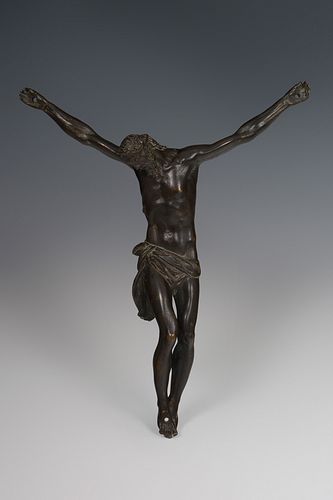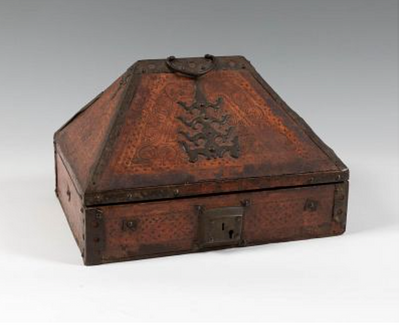Italian Christ of the mid-16th century. Following models by GUGLIELMO DELLA PORTA (Italy, ca. 1550-1577). Blued bronze sculpture.
Lot 48
About Seller
Setdart Auction House
Carrer Aragó 346
Barcelona
Spain
Setdart Subastas was born in 2004 and is currently the first online art auction in Spain with solidity, prestige and reliability guaranteed by our more than 60,000 users. Setdart has a young, dynamic and enterprising team ready to successfully manage the purchase and sale of art works through custom...Read more
Categories
Estimate:
$800 - $1,000
Absentee vs Live bid
Two ways to bid:
- Leave a max absentee bid and the platform will bid on your behalf up to your maximum bid during the live auction.
- Bid live during the auction and your bids will be submitted real-time to the auctioneer.
Bid Increments
| Price | Bid Increment |
|---|---|
| $0 | $10 |
| $200 | $25 |
| $500 | $50 |
| $1,000 | $100 |
| $3,000 | $200 |
| $5,000 | $500 |
| $10,000 | $1,000 |
| $20,000 | $2,000 |
| $50,000 | $5,000 |
About Auction
By Setdart Auction House
Jun 2, 2021
Set Reminder
2021-06-02 07:00:00
2021-06-02 07:00:00
America/New_York
Bidsquare
Bidsquare : DECORATIVE ARTS XVI-XIX
https://www.bidsquare.com/auctions/setdart-auction-house/decorative-arts-xvi-xix-7000
Setdart Auction House sofia@setdart.com
Setdart Auction House sofia@setdart.com
- Lot Description
Italian Christ of the mid-16th century. Following models by GUGLIELMO DELLA PORTA (Italy, ca. 1550-1577). Blued bronze sculpture. Measurements: 23 x 18.5 cm. The Christ we present here follows the model of the crucifix by Sebastiano Torrigiani, derived in turn from a model by his master Guglielmo della Porta, found in the church of San Giacomo Maggiore in Bologna. Thus, we are faced with the figure of Christ crucified with only three nails, accentuating the drama of the scene. This theatricality is enhanced by the elongation of the upper limbs, which support the entire weight of the protagonist's body. Guglielmo della Porta was a renowned Italian sculptor, architect and restorer of Mannerism. The son of Cristoforo della Porta and his wife Caterina, he received his artistic education from his uncle Giovanni Battista della Porta in Genoa. He worked for the cathedral of Genoa during his early years of artistic training already in 1531 together with his brother Giacomo and under the direction of his uncle on the statues of the chapel of St. John the Baptist. In 1537 he moved to Rome and became a disciple of Michelangelo, thus obtaining a greater number of commissions. An example of this is the bust he made for Pope Paul III in 1547, after his death, and the tomb of St. Peter, which was his main work, which occupied him from 1555 to 1575, although it was later revised by Bernini. His career as a sculptor at the court of the Farnese was due to his contact with Mario Maccarone, the supervisor of papal building projects. In 1540, as Della Porta he designed the tomb of Vincenzo degli Ubaldi in the church of Santi XII Apostoli. Della Porta was a lay brother of the Cistercians and was called from 1547 to the papal coinage. Among other things, his studio was commissioned to complement the legs of the torso of Farnese, which was found in 1546. The result was so convincing to his contemporaries that following Michelangelo's own advice he was approved to link the ancient limbs of the statue, which had been excavated. Today his works can be found in different places of great historical and artistic relevance, such as his sculpture of Moses in San Lorenzo de Fiori, or for example his works in the Giuliano chapel of the cathedral of Genoa, in Santa Maria del Popolo, and his bust of Paul III which is in the Museum of Capodimonte.
- Shipping Info
-
In-house shipping available. Please inquire at admin@setdart.com.
-
- Buyer's Premium



 EUR
EUR CAD
CAD AUD
AUD GBP
GBP MXN
MXN HKD
HKD CNY
CNY MYR
MYR SEK
SEK SGD
SGD CHF
CHF THB
THB















